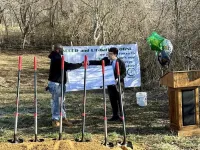Their facilities have remained scattered across the campuses of local partners but now, the collaboration will have a permanent home.
A $2 million gift from The Roe Green Foundation, jointly awarded to CWRU and UH, will advance global health initiatives from each institution and establish a state-of-the-art research hub and gathering place in Uganda’s capital, Kampala: the Case Western Reserve University and University Hospitals Roe Green Medical Education and Research Building.
With support from philanthropist and world traveler Roe Green, the collaborative will have a central facility in which to conduct research, meetings, training and medical care.
“My home is Cleveland, but I am a citizen of the world,” shared Green. “It is my honor to support the work of Dr. Robert Salata and all those physicians involved in our work to improve health worldwide. I hope this new facility in Uganda can be a beacon to others and show what can be achieved when we join in a common cause.”
Green has long supported both UH and CWRU, but this is her first joint donation to the institutions.
“This generous gift is transformative for our work in Uganda, and a meaningful development in Case Western Reserve’s decades-long relationship with University Hospitals,” said CWRU President Eric W. Kaler. “Having a central location for this vital work will elevate our existing projects and allow us to take on more challenges.”
History in Uganda
The Uganda-Case Western Reserve University Research Collaboration (UCRC) was founded in 1986 to help fight the HIV/AIDS epidemic. UH has participated in the UCRC since its inception, thanks to the leadership and dedication of Robert Salata, MD, chair of the Department of Medicine at UH Cleveland Medical Center as well as physician-in-chief and the STERIS Chair of Excellence in Medicine, and program director of the UH Roe Green Center for Travel Medicine & Global Health.
“For decades, the UCRC and UH have worked to improve global health through research and medical education,” said Salata, who is also the John H. Hord Professor and Chair of Medicine at Case Western Reserve University. “We’ve trained more than 200 physicians at our Uganda location, and this new gift from The Roe Green Foundation will not only provide a permanent home for that work, but further expand our impact.”
Kampala partners include Makerere University, the Ministry of Health, the Joint Clinical Research Centre, Uganda Heart Institute, Uganda Cancer Institute and Mulago Hospital, which donated the land plot for the upcoming construction. Collaboration across these institutions has been instrumental to the success of the UCRC, particularly as the scope of the enterprise has broadened far beyond its initial focus to include studies in epidemiology, biomedical sciences and engineering, cancer, and cardiac disease, among many others.
“This gift is a dream come true, as we have longed for the day we could have our own home,” said Moses Joloba, dean and professor of biomedical sciences at Makerere University College of Health Sciences. Joloba is an infectious disease expert who earned his master’s and PhD in pathology at CWRU.
A strengthened partnership
The UH Roe Green Center for Travel Medicine & Global Health was named in 2014 for its primary benefactor, but builds on University Hospitals’ longstanding commitment to helping people travel safely by providing information, treatment and preventive care, both before and after trips abroad. An additional gift from The Roe Green Foundation extended the center’s mission to include combating global health disparities through an international exchange of medical information and expertise.
“Roe’s passion and commitment to bring cultures together for shared learning is inspiring. Her support continues to make a profound difference in patient care and outcomes, both locally and globally,” said UH Chief Executive Officer Cliff A. Megerian, MD, the Jane and Henry Meyer Chief Executive Officer Distinguished Chair at UH.
UH Roe Green Center’s goals align closely with those of the Uganda-CWRU Research Collaboration, which has been at the forefront of medical research and education since its founding. Beyond conducting Africa’s first HIV/AIDS vaccine clinical trial, UCRC researchers have produced more than 350 peer-reviewed collaborative publications and over 400 scientific abstracts across disciplines, with research awards exceeding $252 million to date.
Medical education and training are also integral to the mission of UCRC, and the new facility will offer myriad opportunities for experts from Case Western Reserve, University Hospitals and local partners to exchange ideas. Programs such as the Andrew B. Kaufman World Medicine Pathway at CWRU, which prepares medical students for careers in global health, stand to benefit immensely from the Roe Green Medical Education and Research Building’s central location in Kampala.
"The establishment of this facility, made possible through this visionary gift from Roe Green, extends our deeply rooted commitment to understanding health and disease in Uganda and adjacent countries,” said Stan Gerson, MD, dean and senior vice president for medical affairs at CWRU School of Medicine. “This strategic commitment aligns with our mission in the school to ‘improve global health by linking research to populations in a superb educational environment.’”
###
About University Hospitals / Cleveland, Ohio
Founded in 1866, University Hospitals serves the needs of patients through an integrated network of 21 hospitals (including five joint ventures), more than 50 health centers and outpatient facilities, and over 200 physician offices in 16 counties throughout northern Ohio. The system’s flagship quaternary care, academic medical center, University Hospitals Cleveland Medical Center, is affiliated with Case Western Reserve University School of Medicine, Northeast Ohio Medical University, Oxford University, the Technion Israel Institute of Technology and National Taiwan University College of Medicine. The main campus also includes the UH Rainbow Babies & Children's Hospital, ranked among the top children’s hospitals in the nation; UH MacDonald Women's Hospital, Ohio's only hospital for women; and UH Seidman Cancer Center, part of the NCI-designated Case Comprehensive Cancer Center. UH is home to some of the most prestigious clinical and research programs in the nation, with more than 3,000 active clinical trials and research studies underway. UH Cleveland Medical Center is perennially among the highest performers in national ranking surveys, including “America’s Best Hospitals” from U.S. News & World Report. UH is also home to 19 Clinical Care Delivery and Research Institutes. UH is one of the largest employers in Northeast Ohio with more than 30,000 employees. Follow UH on LinkedIn, Facebook and Twitter. For more information, visit UHhospitals.org.
Case Western Reserve University is one of the country's leading private research institutions. Located in Cleveland, we offer a unique combination of forward-thinking educational opportunities in an inspiring cultural setting. Our leading-edge faculty engage in teaching and research in a collaborative, hands-on environment. Our nationally recognized programs include arts and sciences, dental medicine, engineering, law, management, medicine, nursing and social work. About 6,200 undergraduate and 6,100 graduate students comprise our student body. Visit case.edu to see how Case Western Reserve thinks beyond the possible
END



